Background Information
Genesis chapters five and eleven contain a genealogy from Adam to Abraham. Since the genealogy records the age at which each man fathered the next named descendant, scholars can use the genealogy to create a chronology of early biblical history.
However, various biblical manuscripts preserve varying figures. The Hebrew Masoretic Text provides figures which add up to a total of 2008 years for this period of time, while the Greek Septuagint yields a total of 3394 years. The following chart lists the figures from each of these two texts. But which text is correct?
The following is a summary of The Case for the Septuagint’s Chronology in Genesis 5 and 11 by Henry Smith, and of the surrounding discussion and research pertaining to it. The views expressed do not necessarily reflect those of New Creation.
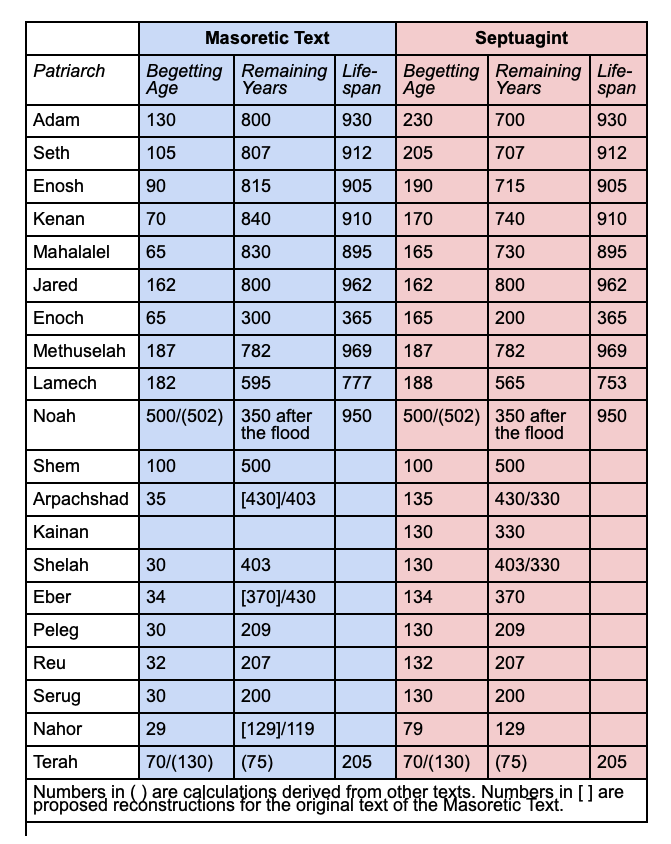
Until the Reformation, the dominant view among Christians was that the Septuagint preserved the most accurate numbers. During the Reformation, however, the Western church began to favor the Masoretic Text.
By the 1890’s, conservatives began abandoning the view that Gen 5/11 yielded a chronology from Adam to Abraham. Discussion regarding which version was the most accurate came to a standstill. Currently, most conservative scholars accept the Masoretic Text as being the most accurate, and most liberal scholars reject the accuracy of any version.
Masoretic Text versus Septuagint
In his 2018 scholarly article, Henry Smith conducts a detailed analysis of the genealogy in Genesis 5 and 11 to determine which version retains the most accurate figures.1 He suggests that scholars have rejected the figures in the Septuagint prematurely. He agrees that most portions of the Masoretic Text have proven it to be the most reliable source, but that in some instances, the Septuagint preserves data which has become corrupted in the Masoretic Text.
Some scholars have rejected the Septuagint version because some variations occur between different copies of the text. However, this should be expected because the Jewish Diaspora and the spread of the church caused the Septuagint version to become widespread, while the Masoretic Text remained under the control of Jewish rabbis. The fact that various versions of the Septuagint exist does not mean that the original version was less accurate than the original version of the Masoretic Text.
Most variations in the Septuagint version of Genesis 5 and 11 seem to be due to scribal errors. It is possible to work backwards, using all the intact versions, to reconstruct the original text.
Chronological Inflation or Deflation?
It is clear that at some point, someone systematically and deliberately revised the numbers in Genesis 5 and 11. For most of the patriarchs, the begetting age varies by 100 years between the Masoretic Text and the Septuagint. In six cases, the remaining years were also amended so that the lifespan would remain the same. It is of utmost importance to determine which set of numbers is correct, since the biblical dates of primeval history are dependent on chronology in Genesis 5 and 11.
Inflation of the Septuagint?

The Septuagint, with its longer chronology, dates to approximately 281 BC, when Jewish scribes in Alexandria, a city in Egypt, translated it from Hebrew. Therefore, either the translators used an original Hebrew text containing the longer chronology, or they fabricated the longer chronology at that time.
Some scholars from the 19th century have suggested that the translators of the Septuagint inflated the numbers to match Egyptian chronology. However, if this is the case, the translators failed in their objective since the Septuagint chronology falls short of the Egyptian chronology by about 1,000 years. Additionally, there is no evidence that the translators made any other edits to accommodate Egyptian history. It seems unlikely that they would have done so in one instance and not in others.
There is no other viable reason that the Septuagint translators would have inflated the numbers, and all evidence suggests that their goal was to provide an accurate translation of the Pentateuch into Greek. Therefore, it is reasonable to conclude that the translators were working from a Hebrew text that included the longer dates.
Deflation of the Masoretic Text?
Messianic Chronology
Eusebius, an early church historian, suggested that the Masoretic Text contained a deliberately deflated chronology in Genesis 5 and 11, and other early writers agreed. Some scholars have suggested that this proposed deliberate deflation was due to calculations regarding the messiah’s arrival. In Second Temple Judaism, messianic chronologies connected with the prophecy in Daniel 9:24–27 suggest that each day of creation represents 1,000 years of world history. The authors of one of these schemes proposed that the messiah would arrive in the 6th millennium after creation and usher in a kingdom spanning the 7th millennium.
Another messianic chronology suggested that the messiah would appear 4,000 years after creation. Using the Masoretic Text, this places the appearance of the messiah around AD 240. It is possible that the deflation of the dates occurred to help discredit Jesus’ eligibility to be the messiah, since in this scheme, he appeared 240 years too soon.
The Power of the Pharisees
This messianic chronology was popularized in AD 140–160. At this point in history, the Jewish temple in Jerusalem had been destroyed by the Romans, and Christainity was spreading rapidly. Judaism was greatly weakened, and the scribes and Pharisees tightly controlled the small core of Judaism that remained. Rabbi Akiba hated the gospel, and it is said that he was so powerful that he could decree that certain Hebrew texts were unfit for public reading, and they would be removed from use.
Someone with this type of power could certainly fall under suspicion of being the one to purposefully deflate the patriarchal chronology in order to discredit Jesus as the messiah. If this is what happened, Akiba’s followers would have also deflated the numbers in their Greek copies of the Old Testament to match the newly revised Hebrew versions.
Smith states, “the rabbis possessed adequate motive, authoritative means, and unique opportunity to systematically revise the sacred text, introduce the shorter chronology…, and remove evidence of the longer chronology. They are the only group who could have made this kind of radical chronological alteration permanent in future manuscripts.”
Internal Evidence for Masoretic Deflation
Begetting Ages
While most of the begetting ages differ by 100 years, Nahor’s varies by 50 years, being 29 in the Masoretic Text and 79 in the Septuagint. If the translators of the Septuagint were responsible for changing the figures, it seems reasonable to assume that they would have consistently added 100 years, making him 129 years old.
On the other hand, if the Septuagint’s figure of 79 is the original, and the numbers in the Masoretic text were deflated, the 50 years difference makes sense because it would be impossible to subtract 100 years from the age of a 79-year-old man.
Additionally, whoever changed the figures in the text avoided tampering with those of Methuselah, Lamech, Noah, Shem, and Terah. Lowering the begetting ages of these patriarchs would create chronological errors with other Bible passages. Raising their ages would not have created any issues. Therefore, the fact that the ages of these particular patriarchs remain untouched suggests that whoever edited the years deflated the chronology rather than inflated it.
“Full of Years”
Another problem with the chronology in the Masoretic Text is that Genesis 25:8 states that Abraham, at 175 years old, “died in a good old age, an old man, and full of years…” This statement makes no sense if, as the Masoretic Text suggests, Eber was 464 years old at the time of Abraham’s death, Shem died at age 600 only 25 years before Abraham’s death, and Noah died at 950 only two years before Abraham was born. In this scenario, Abraham was neither “an old man” nor “full of years” in comparison with his contemporaries.
The Septuagint text makes more sense in this regard, since by the time of Abraham’s death, Noah had been deceased for almost 1000 years, Shem for close to 800 years, and Eber for about 400 years. In the Septuagint’s chronology, by the time of Abraham, lifespans had dropped by enough years that Abraham was “an old man” and “full of years” in comparison to his contemporaries.
External Evidence for Masoretic Deflation
Data From Early Historians
If the rabbis deflated the chronology in the second century AD, then Hebrew and Greek texts from the first century AD and earlier should contain figures matching those of the Septuagint. Not surprisingly, this is the case.
Demetrius, a historian from the third century BC, is the earliest known external witness to the chronology of Genesis 5 and 11. He writes, “[F]rom Adam until Joseph’s brother came into Egypt, there were 3624 years; and from the Deluge until Jacob’s coming into Egypt, 1360 years.” These figures are consistent with the Septuagint, not the Masoretic Text.
Eupolemus, a Jewish historian from the second century BC and a high-ranking Jerusalem official, wrote On the Kings in Judea. His calculations yield a span of 5149 years from Adam to the 5th year of the reign of Demetrius I (ca. 158 BC). These figures match those of the historian Demetrius and the Septuagint.
Eupolemus used the Septuagint and he also had access to Hebrew texts. He did not note any discrepancy between the figures in the two translations, and he based his calculations on the longer dates. Therefore, it seems reasonable to assume that these dates were commonly accepted in his time and the figures in the Septuagint matched those in the Hebrew texts that he used. If they did not match, he certainly would have chosen the Hebrew texts as the most accurate.
Data from Early Histories
The Liber Antiquitatum Biblicarum, also known as the Book of Biblical Antiquities, provides a chronicle of biblical history from Adam to Saul. Although the only surviving copy of this text is in Latin, scholars agree that the original text during the first century AD was Hebrew. The author was probably a Pharisee living in Israel.
The Liber Antiquitatum Biblicarum includes the begetting ages and remaining years of the patriarchs from Seth to Lamech, and the author based these figures on a Hebrew text of Genesis. There is no evidence that he or she consulted the Septuagint, yet the chronology matches that of the Septuagint rather than that of the Masoretic Text.
Josephus was a Jewish historian from the first century AD. In his book Antiquities of the Jews, written around 94 AD, he provides a chronology that matches that of the Septuagint. Yet Josephus explicitly states that he consulted a Hebrew text. Josephus moved in the highest of circles, and would have had access to high-quality texts, perhaps even the Temple library scrolls. This is another piece of evidence suggesting that the Hebrew biblical text in the first century AD matched the Septuagint, not the Masoretic Text.
Proposed Original Numbers in Genesis 5 and 11
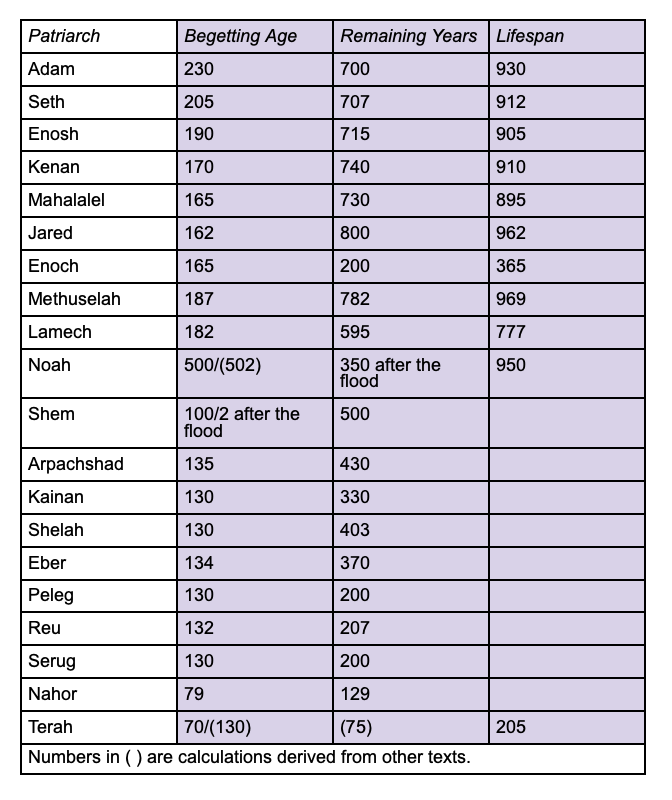
Conclusion
Smith’s research analyzes the chronologies of Genesis 5 and 11 based on internal evidence, Septuagint studies, ancient testimonies, and external evidence. Based on the evidence, he concludes that, “the Septuagint’s primeval chronology, with a Creation date of ca. 5554 BC and a Flood date of ca. 3298 BC, has the strongest evidence favoring its originality.”
Footnotes
- Smith Jr., Henry B. 2018. “The Case for the Septuagint’s Chronology in Genesis 5 and 11.” The Proceedings of the International Conference on Creationism 8: 117–132. ↩︎

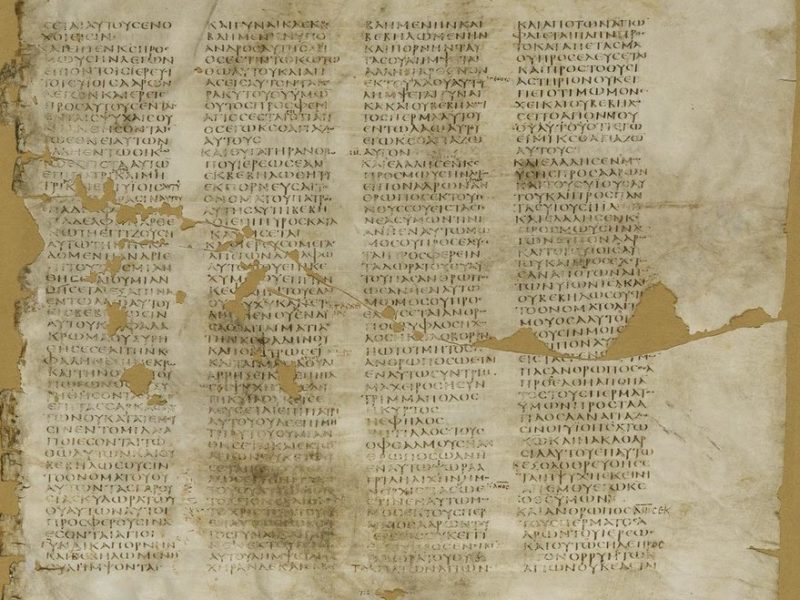


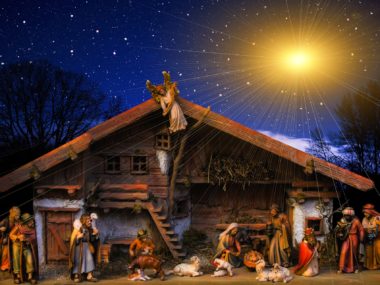
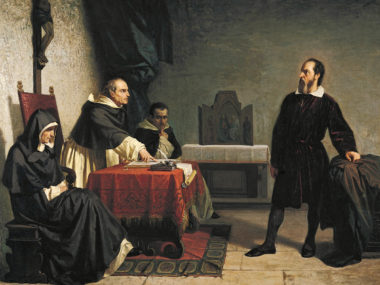
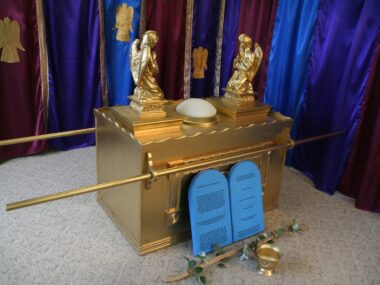





The pop up on your website makes me not want to read or return.
Hi Brady,
Thank you for your feedback!
Thanks Abigail, this is a great article.
Marvellous work.
A very well written easy to read article, however, it fails to mention two important points:
1. A reason for the corruption of the text is to make Shem a contemporary of Abraham with the claim that he’s Melchizedek rendering Jesus’s priesthood illegitimate.
2. There are other well known anti Jesus corruptions in the Masoretic, so this is not the only.
Dear Zaid,
Thanks for commenting on Abigail’s summary of my research. I thought I could be helpful by responding to your comments.
Regarding point #2, you are correct about this. I have been wanting to look at this myself and add it as a supplement to my argument that the MT of Gen 5/11 was systematically reduced for Messianic reasons. The verse with the most potential is Deuteronomy 32:43, which is used in Hebrews 1:6 to show that the angels were to worship the Messiah, i.e. Jesus. The MT looks to me like it has been deliberately altered, vs. the readings in both the LXX and the Dead Sea Scrolls. This particular passage is worthy of an investigation all on its own and there are others as well.
For point #1, the Melchizedek=Shem theory, while providing adequate motive, cannot account for all the evidence. In particular, it cannot explain the shorter chronology of the MT in Gen 5, which has no bearing on the relationship between Mel and Shem. If one subscribes to the idea that the MT correctly preserves Gen 5, then he would have to posit a motive for the LXX inflating the antediluvian chronology. As far as I know, no viable explanation exists in the literature.
Further, Josephus and Liber Biblicarum Antiquitatum both used a Hebrew text of Genesis with the longer antediluvian chronology. The Mel=Shem theory cannot explain this data adequately. That being said, the Mel=Shem Jewish exegetical tradition probably DID arise in response to the NT book of Hebrews’ connecting Jesus with Melchizedek. Since the MT’s chronology was already deflated by the rabbis, they were able to connect Mel and Shem as an apologetic against the Christian connection between Jesus and Mel in Hebrews. To my knowledge, there is no evidence of this exegetical tradition in the Jewish literature before the destruction of the Temple. The Melchizedek Document from Qumran makes no such connection, for example.
I hope this is helpful to you, Zaid.
Blessings in Christ Jesus,
Henry
The Septuagint, with its longer chronology, dates to approximately 281 BC, when Jewish scribes in Alexandria, a city in Egypt —- Garbage text from the country typifying worldliness. Toss the “septuagint” straight into the furnace
Hi Jerry,
As you point out, the Septuagint was translated around 281 BC from the Hebrew text available at that time. There are certainly problems with the Septuagint, and it is far from being the most reliable translation of scripture available. Yet, in my view, it is far from being a garbage text. As Smith points out in his article, the Septuagint is highly valuable for providing insight into the Hebrew text of the 3rd century BC. It, along with other flawed texts such as the Samaritan Pentateuch, can function as tools in correcting scribal errors (or deliberate changes) that have occurred in the Masoretic text over the centuries.
Noah was born in 1,056. 1,056 x (e) squared= 2,021+ 5,781
JOB’S 11.5k animals…=11.5 years…=4 generations (4×1,000) + 140= 4,140=11.5×360.
WEDDING OF CANA…meat plus wine…(8×153) + (6 pots x 3) x 162(firkin)=4,140.
LAZARUS…”are there not 12 hours in a day?” yes and no…12 is half…like 180 is half a year. Jesus goes to Judea (15×40 rods=600=time of Noah) and back 600, and there again 600=1800. Remains for 2 and Lazarus dead for 4=2+4=6=2,160… 1,800+180+2,160=4,140=11.5 years.
SHIPWRECKED SOULS… 276 souls fasted until 14 days; rescued on the 15th…15×276=4,140. Days of Noah is a multiple of 276. Noah went into the Ark in 1,656=6×276.
From lamb separation of Pesach Sheni (Hezekiah’s/Noah’s count) until the 3rd day of the month later Shiloh wedding is 4,140 days.
Year 1,656 of flood plus 290 years until Abram (Abraham). When Abraham was 75 (called out) it was year…2…0….2…1! 1,656+290+75=2,021
I believe in the years BC, you advance in years yet descend in value toward 0. -1656+290=-1366. Add another 75 years you arrive at 1291 BC.
S. Douglas Woodward does a fairly exhaustive analysis of this issue in his “Rebooting the Bible” vols. 1 & 2. He makes af overwhelming case for why the LXX should be preferred over the masoretic–and it’s not simply due to chronology. I find it interesting that this author failed to mention that in over 90% of cases where the New Testament quotes the Old, it agrees with the LXX–particularly when it comes to verses dealing with the prophesied Messiah.
Barry Setterfield likewise makes a very strong case for the LXX, which can be found at https://barrysetterfield.org/.
I appreciate AIG finally addressing this vitally important topic. It’s time to admit that the KJV, while a stunning & important achievement, contains flaws. These flaws are inherited and in no way reflect any protestant malfeasance. Nevertheless, they must be admitted to, explored and corrected now that we have the tools and sources to do so.
Hi! Thank you for your comments. I think that there are many cases in which the Masoretic text preserves the original version, but there are definitely instances in which the LXX is the more reliable version.
Another messianic chronology suggested that the messiah would appear 4,000 years after creation. Using the Masoretic Text, this places the appearance of the messiah around AD 240.
————————‐
The Masoretic-based chronologies I’ve read calculate creation in or about 4004BC, with Christ’s birth at 7-4BC. It’s the Septuagint that puts him at the wrong time.
Henry Smith suspects the Masoretes were motivated to abuse their control of official texts in the early centuries, changing years in order to refute Christians who were pointing out Jesus fulfilled prophecies based in the original dates. Check out CTS 2023 lectures on Youtube.
3298 bc for the flood may work when going backward toward Adam, but not forward to David. David lived around 1000 bc and is 22 or 23 generations later, that means 100 years per generation. Remember that Abraham was incredulous when he was told by God that he would father a child at that age. Here is my visual timeline (no reading) with a 2900 bc flood, which corresponds to the society-altering Mesopotamian Shuruppak flood. https://drive.google.com/file/d/1PJ37VeMfp9FGotHVsUiDuWeSVEQTjaC4/view?usp=sharing